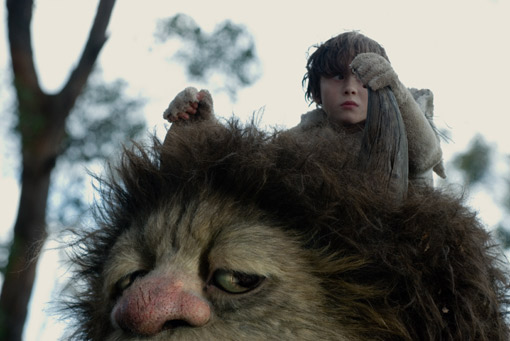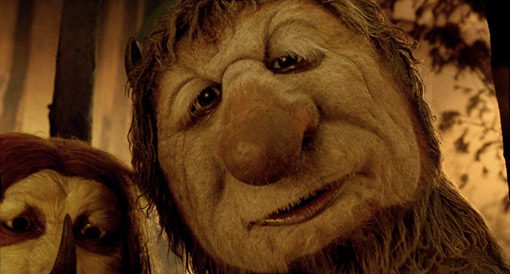Weaving Visual Effects, Animation and Live Action Into Magic
Just as the book met with some fierce criticism when it came out (child psychologist Bruno Bettelheim called it psychologically damaging to children), so the film version went through some dramatic reversals of fortune during its long production history. Reports of children running crying from a test screening, the writer’s strike, and rumors of Jonze being dismissed all combined to push the film’s release back. Although principal photography took place in Australia in 2006, the film was just released.
Jonze, known for his highly collaborative style of working, brought in some familiar faces for this film. That included Lance Acord, ASC, with whom he shot Being John Malkovich and Adaptation. (See StudioDaily article here.) Likewise, for visual effects he tapped another longtime collaborator, VFX supervisor Ben Gibbs, of Dtrain FX in Venice, CA. “I’ve mainly done music videos and commercials working with Spike for maybe 15 years,” says Gibbs. “We’re on the same page when it comes to visual effects. I like how he approaches them instinctually. We gravitated towards each other.”
As proof of concept, they made a short film to sell the studio on what the film would look like. “We essentially approached it the way the film got made,” says Gibbs. “We built a suit and did the facial animation with CG,” he says. “We shot it in Griffith Park, and told a little story about Carol, the main character, and the boy and their interactions, expressing some of the warmth that was occurring and the complications the characters might have.”
“During that process, we were trying a lot of different techniques,” he continues. “Spike is always searching for what feels right. He doesn’t ever go for something totally synthetic. It needs to be tactile. The performance and emotional connection need to be there.”
The short got the film greenlit, says Gibbs, and he next proceeded to “set the tone of the visual effects.” What he means by that is to come up with a way to create effects without any of them seeming synthetic. “Spike can smell a composite,” says Gibbs. “Working with him over the years, it’s rubbed off on me. We approach VFX so they don’t feel like they’re approached as VFX. It’s about being overtaken by the action and atmosphere, with the VFX woven in.”
The most critical principle behind that ideal, says Gibbs, is that Jonze doesn’t “restrict the shooting of the scene around VFX,” but instead approaches it as much in-camera as possible. “You don’t shoot dry elements and then layer them together,” he says. “You try to capture them all as an event.” Though that’s a very challenging way to go about creating visual effects, Gibbs counters that a more by-the-book approach means more time spent on the back end, trying to make the VFX feel right in the context of other shots.

At the Jim Henson Creature Shop, creative supervisor Peter Brooke led the effort to build the animatronic suits. The main thrust of the work, which took place in 2006, was to maintain the size of the wild things vis-à -vis the child, Max. “Our problem was to create something really lightweight, durable enough for a six-month shoot and that would both emote in sensitive one-on-one dialogue scenes and also be able to roll down sand dunes, get hit by huge clumps of dirt and walk into the ocean,” he says.
Initially, the idea was to use some animatronics for the eyes and brows, for use when the wild things were in the background. “They wanted a lot of subtle movement in the mouth and lips, so we decided early on not to try to drive the mouth animatronically, but we thought we might succeed in doing eye blinks and brow movements,” says Brooke.
With animatronics, however, the heads ended up between 3 and 4-feet in diameter, and prohibitively heavy for the Australian actors who would perform inside the suits. Out went the animatronics. The Jim Henson Creature Shop focused on creating suits that would fulfill all the other requirements. “When people build suits, there’s a tendency to build from the actor’s body out,” says Brooke. “You create a mass of material between the actor and the character. If it were eight feet tall and packed with foam, the actor couldn’t move, much less run through the forest. “
Instead, Jim Henson Creature Shop had a different approach, one tied to its origins in puppetry. “We looked at it like big puppets puppeteered by the person inside the suit,” says Brooke. First they built an infrastructure that represented the bone structure, and then created musculature over the bone structure, built of foam and beanbags. The actor wore the suit via a custom backpack that connected his hips to the wild thing’s hips. One benefit of this kind of structure was that air circulated between the performer and the suit, keeping performers cool.

But it was still an arduous job; the suits weighed between 60 and 70 pounds, with the heads weighing between 12 and 14 pounds. To perform, the actor’s movements had to transfer to the wild thing’s movements. Rigid structures connected the actor’s hips to the wild thing’s hips, providing a direct link between the two. The custom backpack distributed the weight to the performer’s hips, not shoulders, making the job of performing in it less tiring.
With the suits completed, Jonze went to Australia to shoot the live action work. The actors had an intense month-long period to learn to perform in the suits. At this point, visual effects supervisor Mark Kolbe came on board to oversee the work of Animal Logic, Iloura, and Rising Sun Pictures, which contributed to the visual effects.
Then came another interruption in production: the writer’s strike. “There was some need to retool the story, but rather than spending money on VFX in the middle of the strike, we stopped for a few months,” says visual effects supervisor Daniel Jeannette, whose background includes a stint at Industrial Light & Magic, where he was character animation supervisor on 101 Dalmatians and animation supervisor on The Mummy, among his other credits.
Two years later, when Where the Wild Things Are was picked up again, Jeannette came on board as the film’s third visual effects supervisor, to bring everything to the screen. “My background is animation, and since the show is so animation-centric, they asked me to take it on,” says Jeannette.
He focused on on figuring out how to animate the faces of the wild things. Jeannette says that, with Blur Studios, they did some tests with facial motion capture. “We didn’t go too far down that road,” says Jeannette. “It didn’t translate well because the faces were so different from human faces.”
Next they made an attempt to do real-time animation, working with the now-defunct company Perform Effects. “We were trying to reconcile the idea of animatronics and live performance, but doing it in the computer,” explains Jeannette. “Real-time animation system uses a data glove connected to the computer that drives the face of the creature.” After six weeks of work, says Jeannette, they stopped. “It was interesting but not quite to the point where you could get a very controlled response,” he says. “We could never hit the level of accuracy that Spike wanted.”
The end solution was to go with a more traditional keyframe animation technique with Autodesk Maya, a task handled by Framestore in London. Next came the choice of whether or not to create a fully CG face. “Rather than recreate all that in the computer, we opted to do a very different technique,” he says. “Rather than create the fur in the computer, we used what was photographed in the plate as textures that we mapped back onto the models.”
That worked out perfectly with what the Jim Henson Creature Shop had done with the heads for the wild-thing suits. “There was a time when we thought, why not just paint the face green?” recalls Brooke. “But we worked with various expressions and picked a neutral expression, but something with a bit of life in it.”

Framestore created a basic structure of the face, with eyebrows, eyes, nose and mouth – “just detailed enough to feel pretty accurate” – and then mapped the textures back onto the face. “The eyes, teeth and tongue were also entirely CG,” says Jeannette. “Then we had a very little bit of CG over the lips and the eyes.”
Jeannette points out that, although Where the Wild Things Are is a visual-effects movie, it was organized like an animated feature. “Framestore had a lead animator and a team of people dedicated to each character, which is very unusual in a movie where you have up to five or seven characters in the frame,” he says. “So, five to seven pairs of hands have touched each shot before compositing. But it was necessary. These characters are acting against Max and it was really important to make it as truthful as possible. It gave us so much more than following a traditional VFX pipeline.”
The technique was very labor-intensive in terms of tracking and compositing. But it was very light in terms of rendering and lighting, since Framestore could benefit from what had already been shot. “We wanted to spend the majority of the time on the animation not the render,” says Jeannette. “We didn’t need to create complex lighting. The key was to create something that would blend with what we’d already shot. We got realism that we would otherwise be unable to sustain with complete CG.”
Although the creatures were the main focus of the VFX work, there were also numerous invisible effects. Jeannette stresses that another guiding principle in the work was to make art design and VFX complementary to one another. (K.K. Barrett was the production designer; Jeffrey Thorp was supervising art director.) The fort was one example of a mix of the two. Quite a bit of it was built practically, but for camera angles that looked toward the fort and the other creatures, the fort needed to be created with matte paintings. Framestore did the bulk of the matte paintings, but Ben Gibbs and Dtrain came back in the picture at this point to create some of the paintings that bring the fort to life.
CG, however, was only used to enhance, not to replace an effect to make it more dynamic. In a scene by the campfire, snow is falling. The snow behind the wild things is practical. “But we couldn’t really have snow falling in front of their faces because of the animation,” explains Jeannette. “We designed CG snow that we composited in front of them, and added some CG snow in front of Max to match the density of snow falling in the rest of the scene.”
In the end, Jonze used VFX and animation in unique ways, to create a uniquely satisfying film. “Everything was challenging because that’s how Spike likes to work,” says Gibbs. “He likes to explore many avenues, reflecting on them and the going down another tunnel and seeing where that leads.”
Did you enjoy this article? Sign up to receive the StudioDaily Fix eletter containing the latest stories, including news, videos, interviews, reviews and more.










Leave a Reply